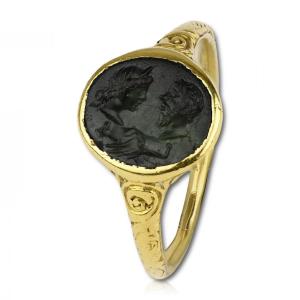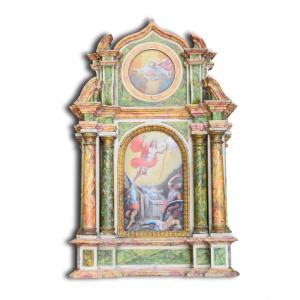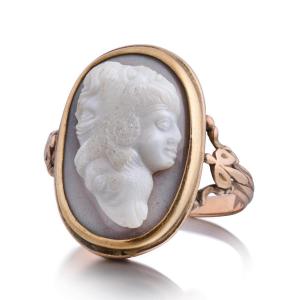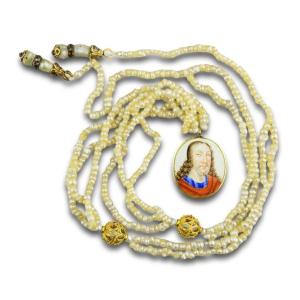French or English, 13th century.
Measures 2.5cm in diameter.
Weighs 4.9 grams.
Provenance: Private English Collection.
The brooch was first noticed in an archaeological journal published in 1846 where it was said to have been found “in the neighbourhood of Rochester” (see last image).
One side bears the Anglo-Norman French inscription ‘+IO SVI:ICI:EN LIV:DAMI’, (modern French = je suis ici en lieu d’ami), which translates as ‘I am here in place of your lover’. The other side bears a seemingly meaningless inscription ‘+RMOABREGPEDET RIE:AV’ – it is decoded by reading every second letter, which yields the names ‘ROBERDT’ and ‘MARGEERIE’. The remaining letters ‘AV’ are of uncertain meaning, perhaps for Latin ‘AVE’ [greetings] or for French ‘A VV' [a vous, meaning 'for you’].
Brooches made of precious metals were worn during the medieval period to signify status and also had a practical use in fastening garments. The inscription on this brooch, which translates as “I am here in place of your lover,” conveys an intimate message of love, implying that it was given to Margery by her lover Robert. The ‘hidden’ nature of the lovers’ names was also part of the game of ‘courtly love’, one of the tenets of which was that the love should be kept secret -- it is listed as the third requirement of the courtly lover in one of the two 'Art of Love' texts that have survived in Anglo-Norman:
Le tierz point de fyne amaunt [The third 'point' for the courtly lover
Si est d'estre bien celaunt... is to be truly concealing (his love) ...
Pur ceo qui voelt bien amer For him who wishes to love well
Covient qu'il sache bien celer it is necessary that he know how to conceal well]
Margaret was doubtless a woman of some standing and thus literate in the English variety of French, the language of culture in England at this period, and quite normal for high-status individuals. The brooch might have been crafted from a gold coin melted down, provided by the person who commissioned it, as gold coins were the most accessible source of bullion during that period.
A ring brooch of similar form and date can be found in the collection of the Victoria and Albert Museum, London, Accession number: M.49-1975
https://collections.vam.ac.uk/item/O15219/ring-brooch-unknown/
Another ring brooch of a similar date with the same inscription (‘+IO SVI:ICI:EN LIV:DAMI’) can be found in the collection of the Metropolitan Museum of Art, New York, Accession Number: 2018.355
https://www.metmuseum.org/art/collection/search/773198
and another example of this inscription on a ring in the collection of the Victoria and Albert Museum, London, Accession number: M.178-1962
https://collections.vam.ac.uk/item/O121948/ring-unknown/
With many thanks to Malcolm Jones for his translation and discovery of the 19th century provenance.


















































 Le Magazine de PROANTIC
Le Magazine de PROANTIC TRÉSORS Magazine
TRÉSORS Magazine Rivista Artiquariato
Rivista Artiquariato